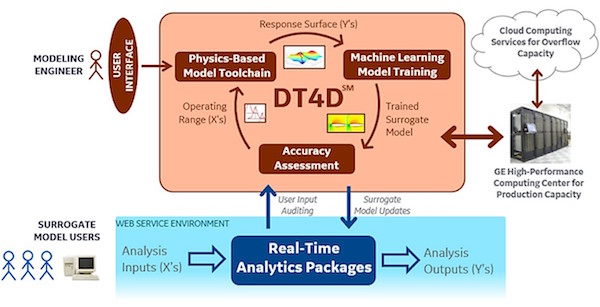
GE is using surrogate modeling to accelerate design and simulation processes. Image courtesy of GE.
Latest News
April 23, 2019
General Electric claims it has found a way to leverage machine learning and simulation to vastly accelerate the design process for its jet engines and power turbines – cutting lead times in half in some cases, and evaluating millions of design variations in just a few minutes.
This artificial intelligence (AI) driven process, called surrogate modeling, could be in widespread use within two to five years, according to this article in Forbes.
GE’s version of surrogate modeling uses a neural network that is trained with using the results of standard computation fluid dynamics (CFD) analysis of design variations. It then estimates the potential conclusions of the CFD process.
According to the Forbes article:
In one test case, in which the researchers trained the surrogate model with about 100 CFDs to figure out the optimum shape for the crown of a piston in a diesel engine, the model was able to evaluate roughly a million design variations in 15 minutes, an increase in speed of 5 billion times. More typically the researchers expect to achieve an improvement of 10 million to 100 million times.
That AI training will get a boost from a new virtual design knowledge library that will store petabytes of simulation and test data, along with schematics. “We can, say, take all the knowledge that went into designing the GE9X or the LEAP [jet engines] and apply it to developing a hypersonic or apply it to a next-gen narrow-body,” says said GE engineer Jim Tallman. “We’re confident that it will provide insights that we wouldn’t have otherwise.”
The surrogate modeling work is part of what GE refers to as Digital Thread for Design (DT4D), which allows for the rapid creation of AI surrogate models, and socialization and threading of the data associated with the models.
Source: Forbes
Subscribe to our FREE magazine, FREE email newsletters or both!
Latest News
About the Author
Brian Albright is the editorial director of Digital Engineering. Contact him at [email protected].
Follow DE





